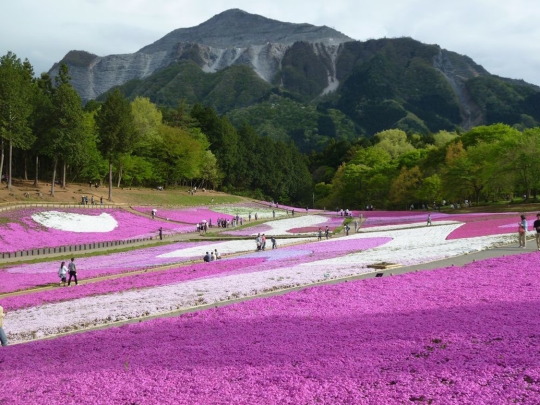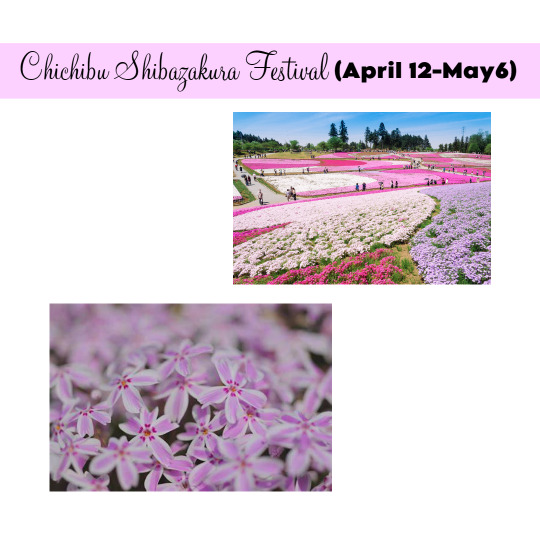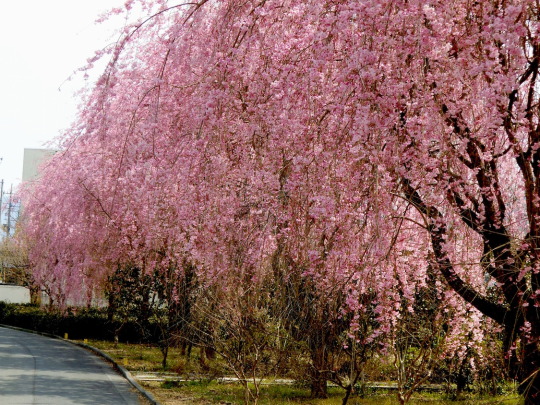#hitsujiyama park
Explore tagged Tumblr posts
Photo


Shibazakura Festival
Mid-April — Early May
From mid-April until early May each year Shibazakura Hill in Hitsujiyama Park in Chichibu turns a sea of pink with moss phlox flowers (芝桜, shibazakura). The many different hues of pink, purple, blue, and white attract a huge number of visitors each year, as well as media attention from across the country. 400,000 shibazakura of 9 species cover the 17,600sqm of the the park during this time, and there are many benches above the fields where visitors can take a rest and gaze upon the vivid colours.
Although Hitsujiyama Park is normally free, an entrance fee of ¥300 is requested during shibazakura season. You can also purchase tickets outside Seibu-Chichibu Station. The park is about a 15-minute walk from the Seibu-Chichibu Station — including a 700-meter fairly steep uphill climb to reach the entrance. During the shibazakura season there is also a large market area just after the main entrance where you can buy food, sake, beer, refreshments, as well as a variety of souvenirs.
#Japanese Culture#Shibazakura Festival#Hitsujiyama Park#Saitama#Japan#Shibazakura#芝桜#Moss Phlox#Festival#Shibazakura Matsuri#Shibazakura Hill#Matsuri#Spring#Flowers#Spring Events#Nippon
12 notes
·
View notes
Text
To be proud or to feel ashamed for standing out?
(Book (Jumbo Jumble) - May 8)

Hitsujiyama Park (Seibu Chichibu (Seibu Chichibu), 30 minutes, 2011)
Less than a 30 minute walk from Seibu Chichibu station, Hitsujiyama is gem in early April with its beautiful cherry trees, but becomes a radiant jewel in early May when the multi-colored grass (primrose) adorns a large area of the park. With Mt. Buko in the background, the picturesque scenery draws in scores of people during this season. Well worth a visit, and can easily be incorporated into one of many possible hikes which the Chichibu area is renowned for.
0 notes
Text

Moss Phlox, Hitsujiyama Park, Saitama, Japan, 羊山公園, 芝桜, 埼玉
3 notes
·
View notes
Text

Tokyo is bursting with gorgeous flowers during the spring season. Aside from cherry blossoms, you can also find various types of lawn-cherry blossoms blooming. Date : 12th April - 6th May Fees: ¥300 Venue: Hitsujiyama Park THANK YOU🙂 http://airbnb.jp/rooms/21581868 #airbnbjapan #cherryblossomfestival2024 #sakura2024 #airbnbtokyo #vacationrental #airbnbtokyo #vacationapartments #vacationmode #japantravel #hotel #hotelroom #airbnbhost #airbnbsuperhost
0 notes
Text
Hoa Nhật Bản
Hoa Nhật Bản là một biểu tượng văn hóa đẹp và tinh tế của đất nước này. Với sự đa dạng và sắc màu phong phú, hoa Nhật Bản mang đến một thế giới thơ mộng và tinh tế , xem thêm chi tiết tại đây.
Hoa anh đào (Sakura) là biểu tượng quan trọng nhất của hoa Nhật Bản. Vào mùa xuân, khi những cánh hoa anh đào khoe sắc trên khắp đất nước, người dân Nhật Bản tụ tập dưới những cây anh đào để thưởng thức cảnh quan tuyệt đẹp và tận hưởng mùa hanami (ngắm hoa). Điều đặc biệt về hoa anh đào là sự tạm thời của nó, chỉ tồn tại trong một khoảnh khắc ngắn trong khi nở rộ, nhưng lại mang ý nghĩa sâu sắc về sự tàn ephemeral và vẻ đẹp không thể trụ vững mãi.
Ngoài hoa anh đào, hoa Nhật Bản còn có hoa cúc (Kiku) và hoa sen (Hasu) cũng được coi là biểu tượng quan trọng của đất nước này. Hoa cúc thể hiện sự trang nghiêm và thanh cao, thường được trưng bày trong các lễ hội truyền thống và các sự kiện quan trọng. Trong khi đó, hoa sen mang ý nghĩa về sự tinh khiết và tâm linh, thường được liên kết với đạo Phật và được sử dụng trong các nghi lễ và thiền định.
Hoa Nhật Bản không chỉ là một phần của thiên nhiên mà còn trở thành nguồn cảm hứng cho nghệ thuật và thi ca Nhật Bản. Từ tranh vẽ, nghệ thuật bonsai đến thơ ca Haiku, hoa Nhật Bản luôn là nguồn cảm hứng không tận cho sự sáng tạo và tinh thần nhạy bén của người Nhật Bản.

Lễ hội hoa Shibazakura - Fuji
Lễ hội hoa Shibazakura ở núi Fuji là một sự kiện nổi tiếng và hấp dẫn tại Nhật Bản. Shibazakura, còn được gọi là "thảm hoa Moss Pink", là loại hoa thủy điệp nhỏ màu hồng, trắng, tím và đỏ, khiến cảnh quan trở nên rực rỡ màu sắc.
Lễ hội hoa Shibazakura diễn ra từ cuối tháng 4 đến đầu tháng 6 hàng năm tại khu vực núi Phú Sĩ ở tỉnh Yamanashi, nằm ở phía tây Tokyo. Đây là thời điểm hoa Shibazakura nở rộ và tạo thành một thảm hoa mênh mông trải dài trên các đồng cỏ. Cảnh quan của lễ hội là một sự kết hợp hài hòa giữa hoa Shibazakura, núi Phú Sĩ và những ngọn núi xung quanh, tạo nên một bức tranh thiên nhiên tuyệt đẹp.
Khi tham gia lễ hội hoa Shibazakura, du khách có thể tản bộ và ngắm nhìn vẻ đẹp của hàng triệu bông hoa trong một không gian rộng lớn. Ngoài ra, lễ hội cũng có cảnh quan tuyệt đẹp từ trên cao, cho phép du khách tận hưởng toàn cảnh của thảm hoa Shibazakura với núi Phú Sĩ làm nền.
Lễ hội hoa Shibazakura cũng đi kèm với các hoạt động giải trí và ẩm thực truyền thống. Du khách có thể thưởng thức các món ăn địa phương như ramen, sushi và mochi, cùng với các màn trình diễn nghệ thuật và văn hóa Nhật Bản.
Với vẻ đẹp tuyệt mỹ của hoa Shibazakura kết hợp với núi Phú Sĩ, lễ hội hoa Shibazakura thu hút hàng ngàn du khách mỗi năm và là một trải nghiệm không thể bỏ qua khi đến Nhật Bản.

Thời gian , địa điểm diễn ra lễ hội hoa Shibazakura
Lễ hội hoa Shibazakura diễn ra từ cuối tháng 4 đến đầu tháng 6 hàng năm. Thời gian chính xác có thể thay đổi một chút mỗi năm, do phụ thuộc vào thời tiết và mùa nở của hoa Shibazakura.
Địa điểm chính của lễ hội hoa Shibazakura là ở khu vực núi Phú Sĩ (Mount Fuji) ở tỉnh Yamanashi, Nhật Bản. Cụ thể, có hai địa điểm nổi tiếng là chủ đề cho lễ hội này:
Chureito Pagoda: Nằm ở thành phố Fujiyoshida, gần Chợ Kawaguchiko, Chureito Pagoda là một ngôi đền có cấu trúc đẹp mắt nằm trên một đồi nhìn ra núi Phú Sĩ. Xung quanh đền là một khu vực rộng lớn với thảm hoa Shibazakura màu sắc tuyệt đẹp.
Hitsujiyama Park: Tọa lạc ở thành phố Chichibu, tỉnh Saitama, Hitsujiyama Park là một công viên rộng lớn với thảm hoa Shibazakura mênh mông. Cảnh quan tại đây kết hợp hoa Shibazakura với núi Phú Sĩ và các ngọn núi xung quanh tạo nên một bức tranh thiên nhiên tuyệt đẹp.
Cả hai địa điểm trên đều có cơ sở hạ tầng tốt, bao gồm sân bay, ga tàu và các phương tiện giao thông công cộng để du khách có thể dễ dàng đến tham quan lễ hội hoa Shibazakura.

Hi vọng bài viết giúp bạn hiểu hơn về lễ hội hoa Shibazakura ở nhật bản.
Hoa Nhật Bản
Bỏ túi 10 điểm checkin sống ảo với Hoa Cẩm Tú ở Kyoto 11 Cánh đồng hoa oải hương đẹp nhất Nhật Bản 10 Địa điểm ngắm hoa Đỗ Quyên đẹp nhất Nhật Bản Du lịch Nhật Bản ngắm hoa Lavender mùa Covid-19 Du lịch Nhật Bản ngắm hoa Tử Đằng mùa Covid 2020
Xem thêm :
Top 10 Ryokan Onsen xịn nhất Nhật Bản 2022 Cách lên kế hoạch cho một chuyến đi Nhật Bản Rượu Sake Nhật Bản là gì? Thuê xe riêng du lịch Nhật Bản cho gia ��ình: hdv tiếng Việt Du lịch Nhật Bản thăm chợ cá Tsukiji
0 notes
Text

0 notes
Text

Family in the Hitsujiyama Park
Chichibu
Google Street View
mai.2017
Edited with VSCO
0 notes
Photo

Moss pink displays at Hitsujiyama Park, Saitama Prefecture, Japan (© Takashi Images/Shutterstock)
0 notes
Photo




Chichibu - Moss phlox (Shibazakura, 芝桜) blossom at Hitsujiyama Park (羊山公園) by cheunwi
341 notes
·
View notes
Photo

7 notes
·
View notes
Text
Live harmoniously—that’s the only way we can survive
(Book (Jumbo Jumble) - April 9)

Seiunji Temple (BushuuNakagawa (Chichibu Tetsudou), 30 minutes, 2014)
This is truly one of the most incredible display of weeping cherry trees in the Kanto Plain. If you hit it right (usually early April), this easy walk from the station will bring you to a flowering wonderland fit for a fairy tale. For those avid hikers, there is a good 4-5 hour hike from here to Hitsujiyama Park (also full of cherry trees at the same time) bypassing the large Tokoku Goddess of Mercy statue.
1 note
·
View note
Photo



Hitsujiyama Park, Japan 🇯🇵
#travel#explore#landscape#wow#trip#nature#traveling#jpg#incredible#holiday#smile#positivity#journey#freedom#outdoor#outdoors#tour
359 notes
·
View notes
Photo

Hitsujiyama Park, Japan, via travelden
1 note
·
View note
Text
15 dei luoghi più spettacolari del Giappone
[shareaholic app=”recommendations” id=”15992024″]
15 dei luoghi più spettacolari del Giappone
Con tutti i post, i video, le curiosità e le bellezze che pubblico continuamente ancora non vi ho convinti che il Giappone è figo e va visto almeno una volta nella vita? Davvero? Davvero davvero?
Se state programmando questo viaggione, magari nel 2021, saprete sicuramente che è molto difficile…
View On WordPress
#Arashiyama#Beauty of Japan#Best japan#Chichibu#Chureito Pagoda#Consigli di Viaggio#Consigli di viaggio Giappone#curiosità#Fushimi Inari#Giappone#Himeji#Hitsujiyama Park#Hokkaido#Japan#Japan landscape#kagoshima#Kumano forest#Kyoto#meguro#Miyajima#Nara#Okinawa#Paesaggi#Paesaggi Giappone#Shirakawa-go#Tochiji#Tokyo#Tottori#Travel Japan#viaggi
0 notes
